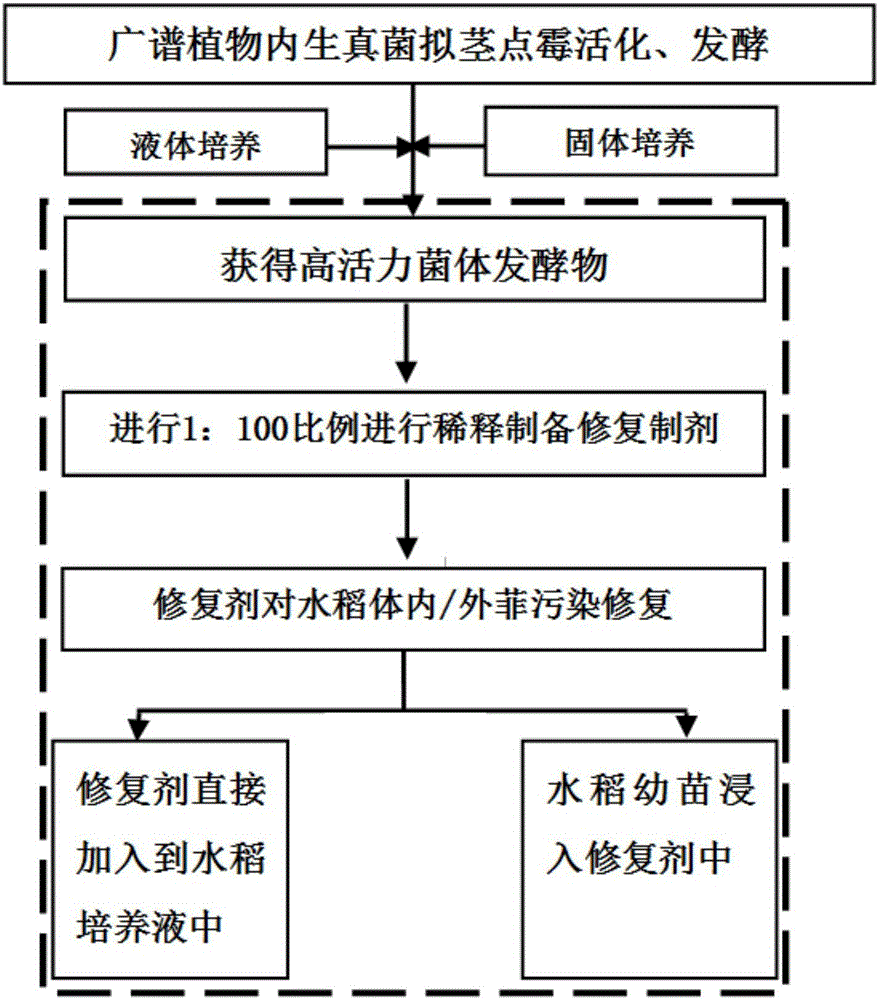Restoration method special for oryza sativa L. polluted by polycyclic aromatic hydrocarbon phenanthrene
A polycyclic aromatic hydrocarbon phenanthrene and rice technology, which is applied in the field of agricultural pollution remediation, can solve problems such as pollution, and achieve the effects of reducing pollution, being easy to control and easy to operate.
- Summary
- Abstract
- Description
- Claims
- Application Information
AI Technical Summary
Problems solved by technology
Method used
Image
Examples
Embodiment 1
[0024] The preparation process is as figure 1 shown
[0025] (1) activate the broad-spectrum plant endophytic fungus (Phomopsis sp.) HQ285146 on the slant respectively, and use the bacterial strains for fermentation to prepare the seed liquid respectively (medium composition (per L): 200g potato juice, 20g glucose, 20g agar), then press 10% of the inoculum was fermented separately (PDA: 200g potato juice / L, 20g glucose / L), 28°C, 150rpm fermentation for 7 days.
[0026] (2) Harvest the fermentation products respectively, dilute them with water, the volume ratio of the fermentation products and water is 1L:50L, and finally prepare the rice phenanthrene pollution remediation preparation.
Embodiment 2
[0028] The rice phenanthrene pollution remediation agent made by the above-mentioned Phomopsis sp. is applied to the rice culture solution containing phenanthrene (50mg / L), and the concentration is 10ml / L, and the rice phenanthrene pollution remediation agent is added after 9 days. In the treatment group, the degradation rate of phenanthrene in the culture fluid was 97%, while in the control group, the degradation rate of phenanthrene was 39%, and the content of phenanthrene in the rice culture fluid decreased significantly.
Embodiment 3
[0030] Soak the phenanthrene-contaminated rice (leaves 116mg / kg; root 1448mg / kg) in the above-mentioned rice phenanthrene pollution restoration agent, then take it out and plant it in the rice culture solution. After 30 days, the degradation rate of phenanthrene in the rice leaves of the treatment group was 88%, the root is 98%; the degradation rate of phenanthrene in the leaves of the control group is 63%, and the root is 89%.
PUM
 Login to View More
Login to View More Abstract
Description
Claims
Application Information
 Login to View More
Login to View More - R&D
- Intellectual Property
- Life Sciences
- Materials
- Tech Scout
- Unparalleled Data Quality
- Higher Quality Content
- 60% Fewer Hallucinations
Browse by: Latest US Patents, China's latest patents, Technical Efficacy Thesaurus, Application Domain, Technology Topic, Popular Technical Reports.
© 2025 PatSnap. All rights reserved.Legal|Privacy policy|Modern Slavery Act Transparency Statement|Sitemap|About US| Contact US: help@patsnap.com

